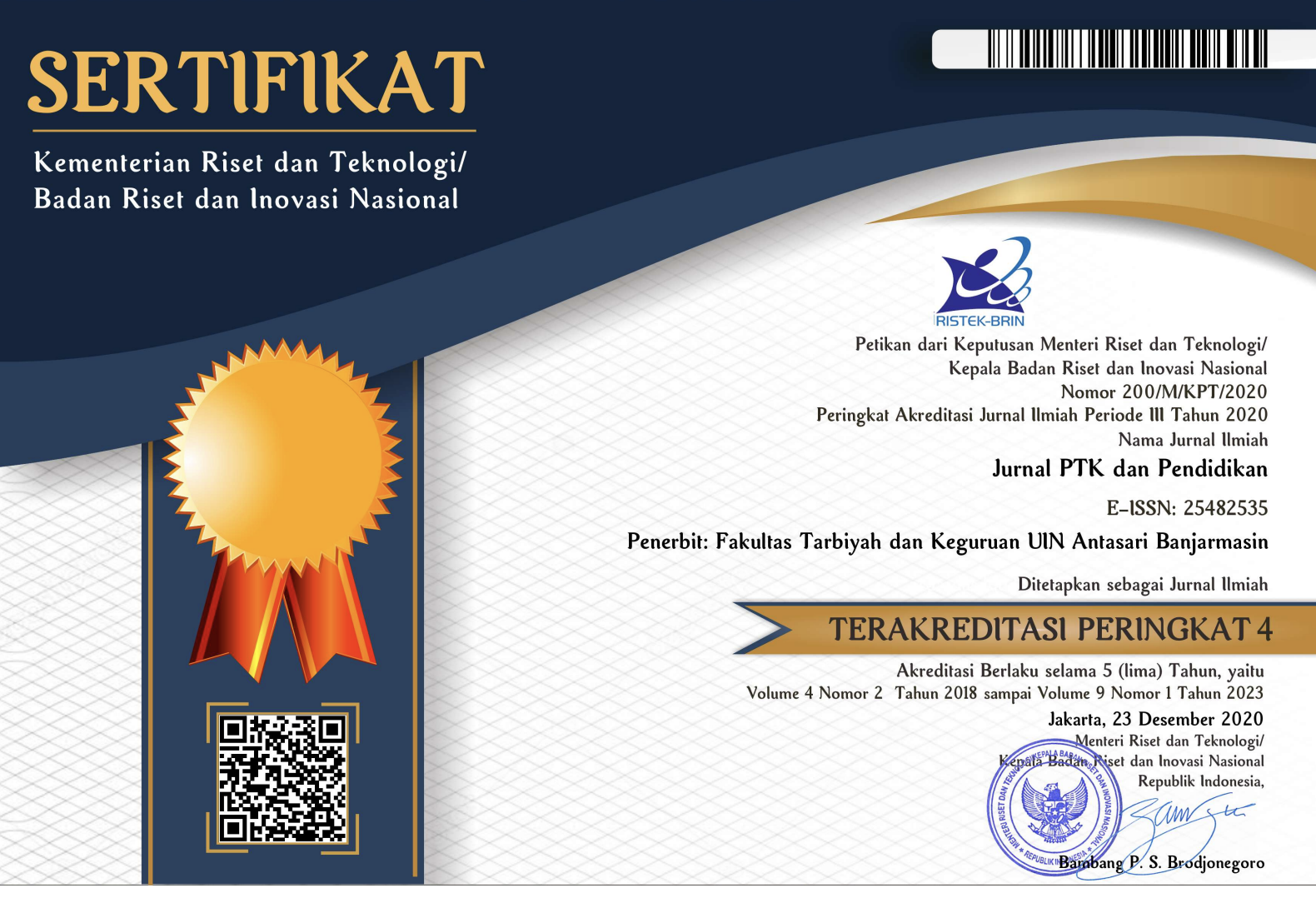The Influence of Students’ Level Ability of Reading Comprehension on The Students’ Translation Ability
DOI:
https://doi.org/10.18592/ptk.v8i1.5767Abstract
This study focused on the influence of reading comprehension ability on translation ability, and we classify reading based on score into three categories they are low, moderate, and high. The data analysis used the statistical formula of SPSS; the data tests were normality and homogeneity tests. Hypothesis testing in this study was carried out using a one-way analysis of variance (One Way ANova). The finding of this study was there was a significant effect on reading level into translation. Therefore, it could be concluded that Ho was rejected, meaning that there was a significant difference between the students’ reading level into translation ability. Implication research for helping teacher for reading comprehension this effect translation.References
Bouchart, M. (2005). Comprehension Strategies for English Language Learners. Scholastic Inc.
Çelik, P. G., & Özcan, L. A. (2013). Determining Proficiency Level in Foreign Language Teaching: The Case of Translation and Interpretation Students. Procedia - Social and Behavioral Sciences, 70, 288–304. https://doi.org/10.1016/j.sbspro.2013.01.067
Creswell, J. W. (2012). Educational research: Planning, conducting, and evaluating quantitative and qualitative research (4th ed). Pearson.
Denton, D. P. (1961). Basic English The Easy Way. Cambridge University Press.
Dolean, D., Melby-Lervåg, M., Tincas, I., Damsa, C., & Lervåg, A. (2019). Achievement gap: Socioeconomic status affects reading development beyond language and cognition in children facing poverty. Learning and Instruction, 63, 101218. https://doi.org/10.1016/j.learninstruc.2019.101218
Dong, Y., & Lin, J. (2013). Parallel processing of the target language during source language comprehension in interpreting. Bilingualism: Language and Cognition, 16(3), 682–692. https://doi.org/10.1017/S1366728913000102
Elleman, A. M., & Oslund, E. L. (2019). Reading Comprehension Research: Implications for Practice and Policy. Policy Insights from the Behavioral and Brain Sciences, 6(1), 3–11. https://doi.org/10.1177/2372732218816339
Fawcett, P. D. (2003). Translation and language: Linguistic theories explained. St. Jerome Pub.
GrelletFrancoise, F. (1981). Developing Reading Skill. Cambridge University Press.
Hashemifardnia, A., Namaziandost, E., & Shafiee, S. (2018). The Effect of Implementing Flipped Classrooms on Iranian Junior High School Students’ Reading Comprehension. Theory and Practice in Language Studies, 8(6), 665. https://doi.org/10.17507/tpls.0806.17
Lesmana, H. (2019). THE CORRELATION BETWEEN READING HABIT AND TRANSLATING ABILITY FROM INDONESIA INTO ENGLISH. PROJECT (Professional Journal of English Education), 2(1), 79. https://doi.org/10.22460/project.v2i1.p79-86
Macizo, P., & Bajo, M. T. (2006). Reading for repetition and reading for translation: Do they involve the same processes? Cognition, 99(1), 1–34. https://doi.org/10.1016/j.cognition.2004.09.012
McCormick, K. (2015). SPSS Statistics for Dummies. 3, 387.
Meng, F. (2009). Developing Students’ Reading Ability through Extensive Reading. English Language Teaching, 2(2), p132. https://doi.org/10.5539/elt.v2n2p132
Mikulecky, B. S., & Jeffries, L. (2007). Advanced reading power: Extensive reading, vocabulary building, comprehension skills, reading faster. Longman.
Namaziandost, E., Esfahani, F. R., & Ahmadi, S. (2019). Varying levels of difficulty in L2 reading materials in the EFL classroom: Impact on comprehension and motivation. Cogent Education, 6(1), 1615740. https://doi.org/10.1080/2331186X.2019.1615740
Nasri, M., & Biria, R. (2016). Integrating Multiple and Focused Strategies for Improving Reading Comprehension and L2 Lexical Development of Iranian Intermediate EFL Learners. International Journal of Applied Linguistics and English Literature, 6(1), 311. https://doi.org/10.7575/aiac.ijalel.v.6n.1p.311
Pallant, J. (2016). SPSS Survival Manual. 377.
Pham, C. T. K. (2017). Reading Comprehension and Translation Performance of English Linguistics Students of Hung Vuong University: A Correlational Study. Translation Studies, 05(03), 7.
Popescu, T. (2013). Developing English Linguistics Students’ Translation Competence through the Language Learning Process. Procedia - Social and Behavioral Sciences, 93, 1075–1079. https://doi.org/10.1016/j.sbspro.2013.09.333
Robinson, D., & Kenny, D. (2012). Becoming a translator: An introduction to the theory and practice of translation (3rd ed). Routledge.
Saddleback Educational Publishing. (2002). Reading comprehension skills and strategies. Level 7 Level 7. Saddleback Pub. https://search.ebscohost.com/login.aspx?direct=true&scope=site&db=nlebk&db=nlabk&AN=435870
Siyyari, M. (2014). The Effect of Teaching Reading Comprehension Skills on Translation Quality of Iranian EFL learners. International Journal of Applied Linguistics & English Literature, 4(1). https://doi.org/10.7575/aiac.ijalel.v.4n.1p.50
Sriwantaneeyakul, S. (2018). Critical Reading Skills and Translation Ability of Thai EFL Students: Pragmatic, Syntactic, and Semantic Aspects. English Language Teaching, 11(4), 1. https://doi.org/10.5539/elt.v11n4p1
Sutopo, A., & Said, R. R. (2020). The Influence Of Reading Comprehension And Vocabulary Mastery Toward Translation Skill. 9(01), 6.
Venuti, L. (n.d.). The Translation Studies Reader. 539.
Vilceanu, T. (2013). Planning for Success. Proactive Behaviour in Teaching Translation Skills to Master’s Students. Procedia - Social and Behavioral Sciences, 76, 873–879. https://doi.org/10.1016/j.sbspro.2013.04.223
Weissbort, D., & Ástráður Eysteinsson (Eds.). (2006). Translation: Theory and practice: a historical reader. Oxford University Press.
Downloads
Published
How to Cite
Issue
Section
License
- The right to publication of all journal material published on the Jurnal PTK dan Pendidikan website is held by the editorial board with the author's knowledge (moral rights remain the property of the author).
- The formal legal provisions for access to digital articles of this electronic journal are subject to the terms of the Creative Commons CC BY 4.0 DEED Attribution International (CC BY) license. This license enables reusers to distribute, remix, adapt, and build upon the material in any medium or format, so long as attribution is given to the creator. The license allows for commercial use.
- Printed and electronic published manuscripts are open access for educational, research and library purposes. In addition to these objectives, the editorial board shall not be liable for violations of copyright law.






